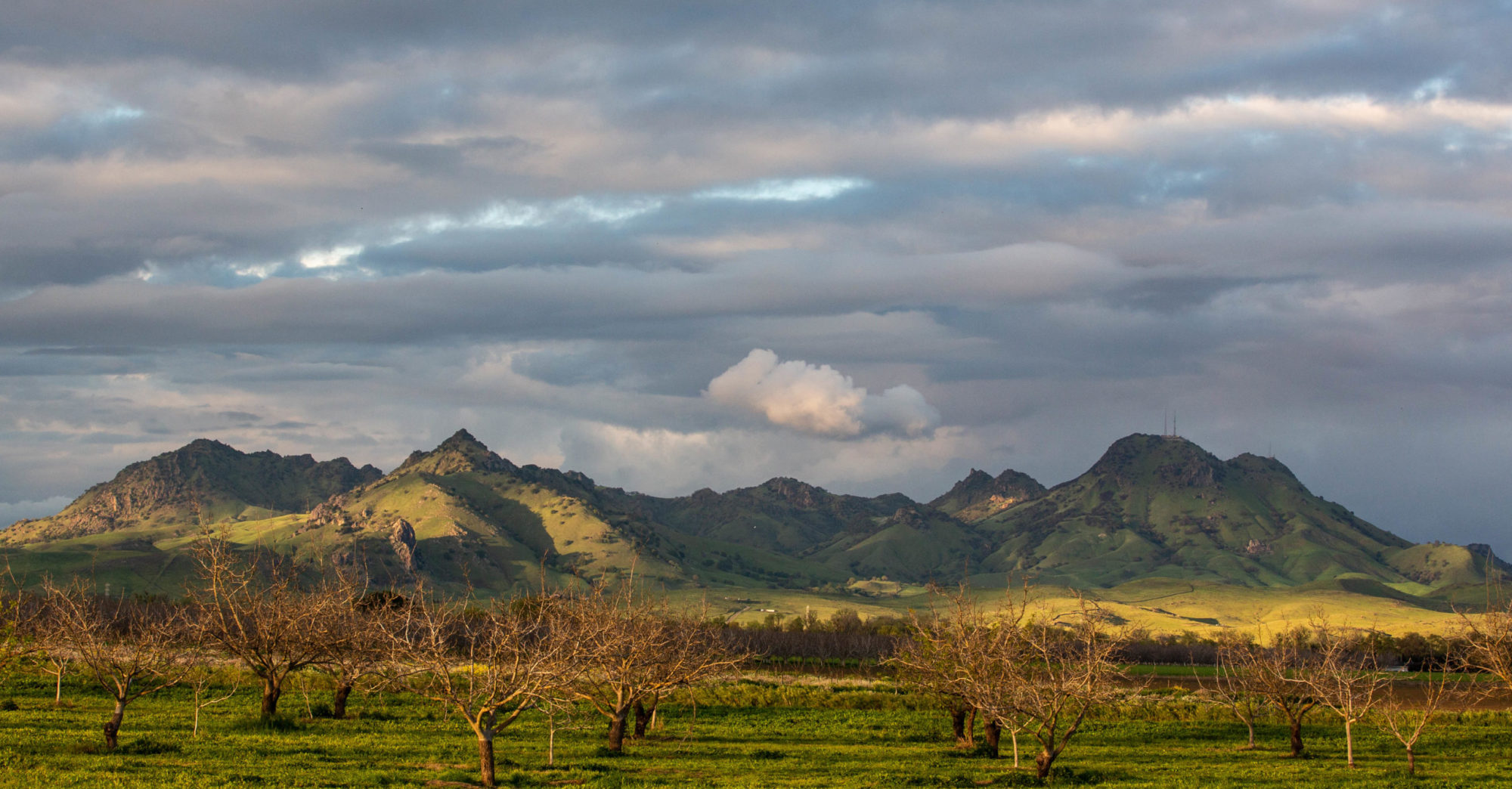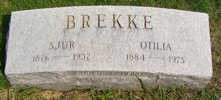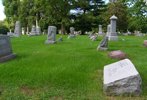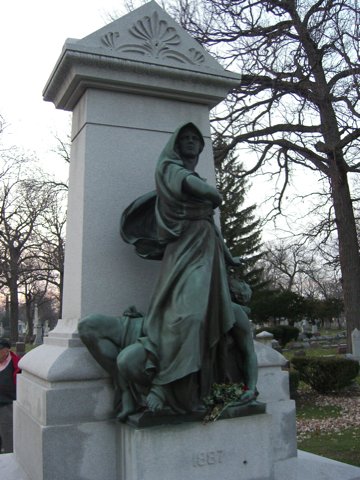
In Chicago post-Thanksgiving. Friday, as part of a ruse to keep my brother Chris out of the house while his surprise 50th birthday was in preparation, we wound up in Forest Home Cemetery just west of the city to visit the Haymarket memorial. More on that later–about Emma Goldman’s grave nearby and the ongoing interest in the site. For now, just the picture.
Silence
By way of Marie, a post from Chicago crime writer Sara Paretsky on the cost of going along with the war and the rest of it:
“I’ve recently returned from a publicity tour of Scandinavia, where my recent novel Fire Sale was published in translation. While I was there, 40,000 Hungarians—out of a population of 10 million—stood outside their president’s house in silent protest because he had lied about the economy to get elected. In almost every press interview I gave, journalists didn’t have any questions about my work, my deathless prose or my characters, or about me. They wanted to know why Americans weren’t in the streets, or some place, protesting what has been done in our names. They weren’t asking in an aggressive, or censorious way; they were asking out of anguish, because we are so powerful, and what we do affects the whole world.”
One More Cemetery Visit
Back in Berkeley now — since late, late Monday night; remind me to bore you with the tale of United Airline’s feat of taking half an hour to move a planeload of bags 100 yards — but I undertook another family cemetery excursion in Chicago before returning west. And another cross-city bike ride, too.
I decided to go out to Mount Olive Cemetery, where my dad’s parents and other relatives are buried. I’ve only been there once: for my grandmother’s funeral, thirty-one years ago this month. Otilia Sieversen Brekke was buried next to my dad’s dad, who died twenty-two years to the day before I was born. I’d never seen his grave before: Sjur Brekke. 1876-1932. He was a Lutheran minister and member of the Hauge Synod, a branch that rebelled against the state-established Lutheran church in the early 19th century (bits of the history here and here). He died when Dad was just 10, of Parkinson’s Disease, long before there was an effective way to treat it.
I rode from Dad’s place, roughly Touhy and Western (7200 North, 2400 West) to the cemetery, near Narragansett and Addison (3600 North, 6600 West). I did an online map of the route I took, but the rough path was: Pratt west to Kedzie; Kedzie south to Irving Park; Irving west to Pulaski; Pulaski south to Addison, and Addison to Narragansett; on the return: Narragansett north to Nagle; continuing north on Nagle to Gunnison; west on Gunnison to Austin; Austin north (with the help of a pedestrian overpass across the Kennedy Expressway) to Bryn Mawr; Bryn Mawr east to Elston; Elston north to Central; Central north to Devon; then winding through side streets east and south back to Bryn Mawr (there’s a river and expressways and forest preserves in the way of a direct route); Bryn Mawr east to California, and California north to my starting point.
Aside from that numbing recitation of street names only a Chicagoan could cotton to, I have to observe that while I had to ride on busy streets with plenty of traffic, the local drivers behaved pretty generously to the freak on a bicycle they encountered. I’m sure riding day in and day out you get to see the same hostile attitude on occasion that’s a daily reality riding in California, but on my two long city rides, I had just one car honk at me, heard no one curse me for being on the road, and saw no raised digits.
When I got to the cemetery, I rode in the gate believing I’d be able to hunt down Sjur and Otilia’s headstone from my thirty-one-year-old memory. I rode in a couple hundred yards and when I came to a turn realized how much I’d overestimated my power of recall. Before I turned back to the cemetery office, I saw a sign listing prohibited cemetery activities. Bicycling was one. I rode back to the gate, went into the office, and asked the manager for help finding the Brekke site, mentioning that I hadn’t been to the cemetery since 1975. He complied with no hint of enthusiasm or engagement, but didn’t say anything about not cycling in the graveyard. He gave me a very general outline map of the grounds and marked the rough location of the grave in Section G, Lot 482. The guidance was good enough, though: I found the spot after looking for no more than 10 minutes. Different from how I remembered it.
When we were down at Holy Sepulchre on Sunday to see my mom’s family burial places, Dad commented on how much more activity there was there than at Mount Olive. Tuesday afternoon, I saw just one car in the cemetery. The place has a bit of an about-to-be-overgrown feel to it. The ground seems unlevel. Stones are leaning and atilt, and rows don’t seem to line up. The grass is a little long. It’s not a bad feeling, in itself; the trees out there are beautiful. It’s just that the families that buried parents, spouses, siblings, and children here have gone somewhere else — California, for instance. They don’t come back often or at all, and nobody’s minding Uncle Ole’s little patch up there on the Northwest Side too closely anymore.
A friend of mine recently called cemeteries a waste of valuable property, and I know what he was saying. It’s a lavish use of land. Out of necessity, mostly, other cultures seem to remember the dead a bit more economically; in Japan or China or India, where land is food, it would be reckless to give so much to those who no longer need it. The thought came to me while I was out amidst the Brekkes and Reques and Sieversens (all my dad’s folks) that cemeteries are memory; that’s what gives them value, that’s what makes them poignant and absorbing even when you know nothing about the people you encounter there. Our national fascination with genealogy aside, though, memory — the kind that tries to weigh the past, personal and collective, not to romanticize it but to provide context and maybe a lesson or two for the present and future — doesn’t look like a hot commodity. People without that sense of memory, of the value of memory, of the importance of connecting today with what’s gone before and what’s to come — for them, cemeteries might really be a waste.
Cemetery Visit
Our mom died three years ago last week, and she’s buried (or interred or however you want to say it) at Holy Sepulchre Cemetery on the far South Side, along with her parents and a couple of her brothers, one set of grandparents, assorted uncles and cousins, and our brother Mark. Not that everyone is buried in one neat group. Far from it. There are two graves here, three there, and then a big grouping of about a dozen O’Malleys and Morans.
The earliest grave in the O’Malley-Moran grouping is from 1928; the latest 1964. Five of the graves date from a single year, 1939, and four of those from a single date, August 22. That’s the date of what I remember my mom calling “the dunes,” when Mary Moran and Mary O’Malley — her first cousin and aunt, respectively — and John Moran and John Hogan — an uncle and her 11- or 12-year-old brother — drowned at Miller Beach in the Indiana Dunes.
We grew up hearing about the dunes: It was the day after a big storm on the lake, and a rip current swept our mom, three months shy of her tenth birthday, and the others into deep water. How my Uncle Bill, who was 13, was nearly dragged in, too, but escaped and ran up the beach for help. How Mom was rescued just at the point of drowning and was revived on shore (the identity of the rescuer was unclear until a few years ago; a few years ago, it emerged as another cousin, Joe O’Malley, who was only about 17 at the time). The terrible aftermath of funerals and guilt.
But until my mom died, I never visited the cemetery or really knew where the family was buried. It was only last year that my dad showed me the Moran and O’Malley graves, and that was the first time I saw where the people who had drowned were buried. There’s a small mystery about the burials, though: One person, my mom’s brother John, is unaccounted for among the markers on the family lot. The cemetery’s records show he’s there, somewhere. But either his grave was never marked or the stone has been buried or lost. My dad’s started trying to sort out where he is.
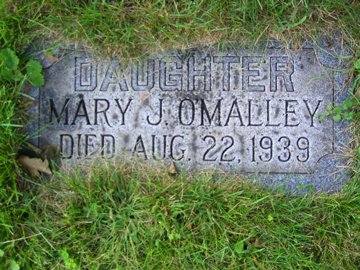
In the meantime: Of course, the drowning always seemed real to me. My mom’s account was detailed and haunting. When I was 17 or so, we drove out to Miller Beach, and she showed me the big house the family had rented for a couple of weeks that August. Even so, coming upon the graves — This is the Aunt Mary that Mom talked about, the one who washed her hair that day and insisted she wear a bathing cap — gives the story another dimension, an objective dimension, it really hadn’t had for me before.
Technorati Tags: chicago
Chicago Connectivity Notes
Sporadic posting, email reading, and Web off-goofing in Chicago. Not because America’s Greatest City lacks for newfangled electronic contrivances, including those of the Internet variety. But because connectivity is not readily available during my laptop-toting visits here (which probably turns out to be a good thing, since that makes me actually talk to people and go out and see things, like Millennium Park and that North Side Starbuck’s that the Wobblies are trying to organize. So: Not a complaint; I’m just saying.
(One thing I notice, though: My family is used to seeing me turn on my computer and just getting on whatever household Wi-Fi network happens to be in range. A couple years ago, I could do that just about anywhere because most of the people who had set up wireless seemed to have skipped the part of the Wi-Fi router manual that told them how to restrict access to their networks. Now, most of the wireless nets I see require a password to get on; that shuts out the likes of me, those neither inclined to try to crack someone’s security nor proficient at the tricks or tools you might need to do that. So either people are learning or the manuals are shorter and easier to read.)
Technorati Tags: chicago
Three Days in Chicago
Day Three
Starting with today, the reason I’m here this time: It’s my dad’s 85th birthday. We’re having a barbecue and Ann and Dan’s — my sister, my brother-in-law — at their place on the northwest side. Beautiful day for it. Sunny, in the low 70s, with a non-prevailing wind and a few clouds pushed this way from that hurricane in the East.
Pop: Happy birthday. Again!
Day Two
My bro-in-law Dan Wasmer and I got on our bikes and rode from the Wasmer-Brekke homestead down to my brother Chris’s place south of Interstate 80 in the south suburbs. By car it’s a 43-mile trip, so not the impossible dream in terms of getting out and riding it. But here’s the thing: The city itself presents itself as a kind of barrier; that’s especially true when you try to ride west out of the northwest side: O’Hare is a giant obstacle that needs to be navigated around; no problem in a car, a pretty good challenge when you’re on your own on two wheels. Riding south, the challenge is a little different: Finding a route that’s reasonably direct and that avoids the unseen terrors of non-Caucasian, non-Spandex-wearing neighborhoods; also, finding a route that keeps you off the busiest streets. Because, though you see tons of cyclists on the lakefront bike paths — too many; too many who are still getting the hang of riding; too many riding among too many pedestrians and runners and random path-crossers; too many to ride at an expeditious pace and feel safe — you don’t see a lot of people on the streets and roads.
We headed south from the northern end of California Avenue until it’s interrupted at Lawrence; we jogged west on Lawrence and then southeast on Manor back to California; then to Grand Avenue, then east to Damen; then Damen down to Blue Island Avenue, and west on Blue Island (which turns into 26th Street) back to California and the Cook County Jail complex; down California to 71st, then, after a brief sojourn on some side streets not all that far from my mom’s old neighborhood, back east to Western Avenue. Western is busy but not impossible at that point; we had one car full of guys yell something at us — whatever it was, I greeted it with a friendly wave — and we rode all the way out of the city before we turned west again, on 123rd. That took us to Kedzie before we hit a detour; Kedzie was fine, and we took that to 175th, then south on Central Avenue, across Interstate 80 just west of the I-57 junction, then a few more miles south (to Vollmer Road, then Harlem Avenue) to Chris’s place. Our mileage: 43 miles, the same as driving (and going at a reasonably friendly pace, we made it in three hours, even with all the traffic signals we hit).
So now I know how to do that.
Day One
Took the 6 a.m. United flight from Oakland to Chicago. Encountered major confusion and building frustration (other travelers’, not mine) at the United check-in counter. My experiment on this flight: I took my handheld GPS unit to see if it would work. I got a window seat (to work, the GPS needs to simultaneously “see” at least tglobal positioning system satellites). I managed to get a window that I couldn’t really look out of, though, it was far enough aft of my seat that the only way to get a view was to lean my seat way back; I prefer not to do that because I know how unpleasant it is have the seat in front of me pushed back in my face. But I did manage to figure out a way to prop up the GPS in the window. When I turned on the device 10 minutes after takeoff, it had no problem acquiring signals from half a dozen satellites, and it worked throughout the flight. The result: I have a track I can view to see the path we took, which admittedly may not be interesting to anyone but me. The problems I found: Since my window was in an awkward position, I couldn’t really move the GPS much to check the map display while we were en route; and I also found the 2-inch display pretty hard to read. The thing to do would be to figure out how to connect the unit to a laptop so you could get a nice big display of the route as you’re moving. Next time, maybe.
When You Care Enough …
Looking for route information for a Chicago-area bike ride, I came across this dark, ironic and bitterly funny highway-safety site from the Chicagoland Bicycle Federation: drivewithcare.org. It pitches “Bob Fuller’s Roadside Memorials,” a service that promises careless drivers a way to show they regret killing people along the road:
“If you drive carelessly in the City, eventually you’ll kill somebody. When you do, turn to us. Just call from the scene. We’ll deliver a fitting handmade Roadside Memorial in 30 minutes or less. Choose from our handcrafted collection, or personalize your own. A Bob Fuller Roadside Memorial is a tribute to the person you killed. A way to say, ‘I’m sorry.’
Motorist/killers can choose from several themed memorials, including “The Jogger” ($19.95 — comes with a pair of used running shoes draped around a centerpiece cross).
Vacation Video Experiment
I had my camera out when our flight was taking off from New York for Oakland the other day. I’m not sure if a camera is on the list of electronic devices you’re supposed to keep shut off during takeoff and shortly after, and I don’t want to draw attention to myself by asking the flight attendants. So on Wednesday, I switched the camera to video mode and recorded the first couple of minutes as the plane rolled down the runway at JFK and climbed to 2,000 feet. The next part of the experiment was putting the takeoff video online. That turns out to be easy. I downloaded the file to a computer, then uploaded it to YouTube (it’s a 60-megabyte file, and it took a while to send over our DSL line). Check it out below.
Trying to look past the novelty of the thing — yes, I’m somewhat slackjawed that this kind of video publishing is so straightforward for someone with little technical ability — this sort of tool really does open up new possibilities for self-publishers (artists, journalists, etc.) of all kinds. [Postscript: I went back to YouTube to look for other takeoff videos. What an original idea: A search turns up 827 hits — many of which are commercial airline takeoffs shot at airports all over the world.]
In Which We Gather by the River
A story in four parts.
I. Non-Confluence
Taking up where we left off last August, my dad and I — this time with my brother Chris — drove out to southwestern Will County on Monday to see if we could see the place where the Des Plaines and Kankakee rivers meet to form the Illinois River. Why? Well, the reason to care about the rivers is that in the mid-19th century they, along with the Illinois and Michigan Canal, represented the link between Lake Michigan, the Great Lakes, and the entire eastern United States and the Mississippi, the Gulf, and the country to the west. On top of that academic-sounding justification, there’s the relative obscurity of it. Who else is driving around the Chicago area looking for this spot? (Some good Web background on the I&M Canal, by the way: from the Chicago Historical Society (including pictures of canal sites in present-day Chicago settings); the Chicago Public Library (part of its “Down the Drain” site on the city’s sewer system); the National Park Service, and Illinois Department of Natural Resources.)
When we visited the area last summer, we hit the towpath along the canal a little too far to the west for it to be a reasonable walk, given my dad’s cantankerous knees. This time, we drove into a county park (McKinley Woods; among other things, the brief history posted at the park says it was a POW camp during World War II) and started walking east on the towpath. The canal runs to the north of the path, and the rivers to the south. About a mile from the McKinley Woods parking lot, after passing a little marina on the opposite bank, we came to a what appeared (to me) to be a spit of land that marked the separation of the Des Plaines and Kankakee rivers. Pictures were duly snapped and huzzahs sounded, and we walked back to the parking lot.
   |
It was only in the course of writing this, though, that I discovered to what an extent I had betrayed the legacy of Louis Joliet, the 17th century French-Canadian explorer who traveled up the Illinois River to the Des Plaines and then on to the Chicago River and Lake Michigan and quickly realized the feasibility of a canal connecting the lake to the Illinois and Mississippi. The “confluence” I located was in fact just an island in the Des Plaines River. The real merger point was west of the lot where we parked, not east.
I guess we have an excuse to go back and look for the spot a third time. (Pictures, from left: Dad on the Illinois and Michigan Canal towpath; a glimpse of the false confluence; the I&M Canal, with the river bluffs in the distance.)
II. Country Cemetery
From the non-confluence of the rivers, we got on Interstate 55 south, headed for Lexington, about 70 miles away. Our destination was the cemetery in Pleasant Hill, a hamlet two or three miles outside town. My old high school English teacher, G.E. Smith, died in April and was buried there alongside his mother and stepfather. I visited Pleasant Hill once, around 1971 or ’72, when G.E. went down to check up on his family’s old home, which by then amounted to a falling-down house and a cellar with a roof on it. He was attached to the place, but it wasn’t until later that he seemed to act on the interest, writing a column in Lexington’s weekly paper about Pleasant Hill history and then becoming a serious genealogist and trying to gather all the strands of the family that had wound up out there on the prairie.
The Pleasant Hill cemetery goes back to the first half of the 19th century. The area’s first white settlers, who arrived in 1820, are buried there. The little town used to have two churches, but those are long gone. The cemetery grounds are unfenced and merge into the bordering corn and soybean fields. G.E.’s grave is on an east-facing slope; his freshly cut brown-red granite stone announces his middle name, Edward, a matter that he liked to keep to himself. It describes him as “teacher, counselor, writer,” and includes a quote from him: “My highest goal was always and still remains simply this: To be able to look back upon my life, from any point along the way, and be able to say that this little corner of the world that my life touched has been made better, not worse, because I touched it.”
When we arrived, in early afternoon, it was clear and very warm and the caretaker, Ron Eckhart, was watering new sod on G.E.’s grave from a tank on his red pickup. He’s been the caretaker for 26 years — “That’s a lot of grass cut,” was how he put it — and long before that, his dad was pastor at both of the Pleasant Hill churches. Eventually Ron moved off to another part of the cemetery, and so did we. Up the hill from G.E.’s spot is the oldest section of the cemetery, filled with people from the days before the Illinois Central bypassed Pleasant Hill and doomed it to perpetual hamlet-hood. With only the graves to go by, you would guess life was hard. There’s the usual large complement of children who died in their first year or two; but there are also seemed to be a lot of adults who didn’t make it out of their 30s. Maybe life was just hard everywhere when these people were trying to make farms and towns. For one example, take a look at the life of another Prairie Stater, Abraham Lincoln: His sweetheart was carried off by a fever at age 20. Just one of his four children survived to adulthood.
 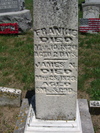 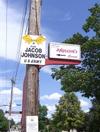 |
Looking around the little cemetery, it looked like G.E., who was aged 81 years, three months and a day when he died, is one of its oldest residents.
III. Wrecked
We drove through Lexington to start the drive back toward Chicago. On the way out to Pleasant Hill, Chris had pointed out the placards on every telephone poll downtown bearing the names of local soldiers serving in Iraq, Afghanistan and elsewhere. Chris counted 19 names. The town has about 2,000 residents, so roughly 1 percent of the population is serving. We fueled up at the Freedom gas station — just $2.899 a gallon — then headed north on old U.S. 66 to Chenoa. I wanted to take U.S. 24 east to Interstate 57 both because I knew there was a Dairy Queen along the way (in Fairbury) — my dad’s favorite road-trip stop — and because I remembered a little piece of local history along the way: the Chatsworth Wreck.
Back in the mid-70s, I stopped to read a historical marker just outside Chatsworth, one of the series of farm towns strung along U.S. 24. It reads:
THE CHATSWORTH WRECK
MIDNIGHT, AUGUST 10-11, 1887
One-half mile north on the Toledo, Peoria & Western Railroad occurred one of the worst wrecks in American rail history. An excursion train – two engines and approximately twenty wooden coaches – from Peoria to Niagara Falls, struck a burning culvert . Of the 500 passengers about 85 perished and scores were injured.
We stopped at the DQ in Fairbury, then continued on through Chatsworth to the wreck marker, which is about two and a half miles east of town, nearly on the Livingston-Ford county line. One thing that’s a little unclear when you’re at the roadside, though, is exactly where the disaster occurred. The TP&W tracks — the railroad still goes by that name — are a half mile north of the highway. I wanted to see if we could find the site of the notorious “burning culvert” — actually, a small wooden trestle. I imagined there could be a memorial or marker at the spot where the train left the tracks.
We parked at an electrical substation near the railroad’s marked but unguarded level crossing. My sense, based on the marker’s placement west of the section road that runs up the county line was that the wreck site was west of the road, too. Chris and I walked along the single track until we got to a culvert maybe a quarter-mile west of the road. It’s not deep — in fact, it’s a narrow ditch that crosses under the track through an 8- or 10-foot-diameter steel pipe. The site is unprepossessing, just like every foot of track east or west of it to the horizon, and there was nothing to suggest we were at the scene of a sensational event.
After we walked back to the car and started east again on 24, Chris and I spotted another culvert — this one an actual trestle — just east of the county line. We turned around and hiked out to it, too. It’s a much more satisfying place for a calamity: The tracks cross a bridge that’s about 75 feet long and a good 20 feet above a sluggish little creek. We agreed that between the two possible sites, this seemed the more likely.
Back at home, I poked around online to see if I could find some account that sheds light on the wreck’s precise location. Chatsworth had a newspaper, the Plaindealer, in 1887, and much more recently, a retired teacher and local historian there, Helen Louise Plaster Stoutemyer, published a book on the disaster, “The Train that Never Arrived.” Eventually, I came across a Chatsworth native’s website that includes the Plaindealer’s first account of the tragedy. The story says the train left the tracks at “the first bridge west of the county line” — the first place Chris and I looked. In addition to offering the salient facts, the writer has a lot to say about the impression the wreck left:
“The sight was most terrible. … It was too horrible to admit of description. The screams and moans of the wounded were heartrending, and the terror of the sight can not be imagined. … To add to the terror of the scene a heavy thunder and lightening storm came up, and , with heavy rain made such a scene as would appall the bravest hearts. … Even the strongest men were forced to tears as they heard and saw the anguish of the unhappy excursionists. While many displayed strong courage, grit, and heroism, others were almost frantic, and those in attendence upon them were forced to hold them to prevent acts of insanity and self-destruction.”
If you like the newspaper’s rendition, then you’ll love the song: “The Chatsworth Wreck.”
 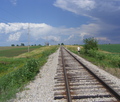 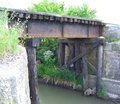 |
(Pictures: Left: The marker, east of Chatsworth on U.S. 24. Middle: Wreck candidate site A (west of the railroad crossing 2.5 miles east of Chatworth; north end of culvert is just visible on far left). Right: Wreck
candidate site B — east of the crossing.)
IV. Wrecked Again
After investigating the site of the 1887 trackside carnage, we turned east again on U.S. 24. The highway crosses Interstate 57 at Gilman, then crosses Highway 1, which follows an old trapper’s trail from the Wabash River up to Chicago, at a town called Watseka. I was curious to see Watseka, which I’ve passed through exactly once: In the autumn of 1966, when Dad took us on a long-weekend trip down to the Smoky Mountains and back. I remember going through there late on a Thursday night that ended at a Holiday Inn just outside Indianapolis.
As we started to get close, I asked Dad and Chris whether they remembered the big disaster that had happened in Watseka around 1970. It didn’t ring a bell with them. I recounted the big blast and fire in town — apparently some kind of gas explosion — and an image I still vividly remembered. A fireball rising far above the old-fashioned town water tower.
A couple minutes later, a town came into view. There was a newish water tower rising up in the middle of town. I thought I was looking at Watseka, and said something like, “See, that must be the replacement for the old water tower.” Chris was driving, and noticed the town limit sign: Crescent City. He spotted a historical marker on the left side of the road. As we passed, he asked whether we should stop. Yes, let’s. We went back, and the marker turned out to be a small pavilion with some displays. In fact, a big blowup of the picture I had described — water tower, fireball — was the centerpiece in one of the displays. Somehow I had transferred the disaster — which occurred June 21, 1970 — to the next town over.
The cataclysm involved the same railroad that ran its train off the tracks in Chatsworth in 1887, the Toledo, Peoria & Western. Several liquified propane tank cars derailed in the center of Crescent City on Father’s Day morning. The town fire department responded and fought for an hour to prevent an explosion before the first car finally went off. At that point, according to a hand-written reminiscence that’s part of the memorial, “the boys retreated and let fate take its course.” Sixty-four people were hurt (mostly firefighters who suffered second- and third-degree burns), none killed; the center of Crescent City was obliterated. The president of the TP&W issued a statement accepting responsibility for the blast and apologizing for “the inconvenience.”
  |
More on G.E. Smith
Happy 80.5, G.E.
A Teacher
A Teacher (2)
Expressway Summer
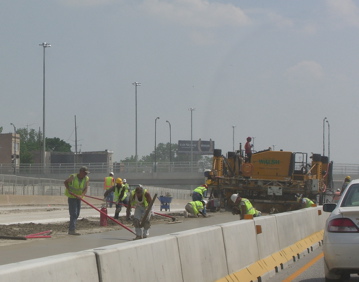
Expressway reconstruction: a rite of Chicago’s non-winter season. Chicago’s not the only place this happens, but from my outsider’s perspective, late spring/summer/fall-until-it-snows seems to be given over to large-scale highway projects. This year, the Dan Ryan Expressway on the South Side is being rebuilt. Not repaved — reconstructed from the roadbed up. The middle eight lanes — the “express” lanes, four northbound, four southbound — are torn up right now; that leaves three lanes in each direction in the main construction zone (from about 13th Street to 71st Street).
Mid-afternoon Saturday, we got a nice view during our slow-but-not-horrible progress down the Ryan (towards my brother Chris’s suburban manse in far-off Tinley Park). We headed back north Saturday night just before midnight. The work was still going on (what sort of overtime and weird-shift bonuses are these highway workers making?).
